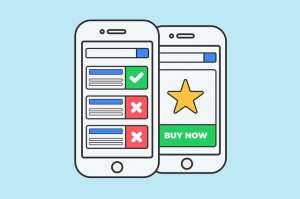The way we search for answers and recommendations has fundamentally changed. This is due to the emergence of smartphones, increased access to information, and other factors. “Googling it” is a common phrase in our vernacular and, according to a recent study, the average person will spend five years of their life browsing social media.
It’s easier than ever to search online to find the services you are looking for. Consequently, it’s more competitive than ever. Hence, the reason why digital advertising has become a critical part of any dental practice’s marketing plan.
So you’re ready to implement digital advertising for your practice. How do you know which platform is right for you? In this article, we’ll break down the key differences and comparisons between the two platforms to help you make a better decision.
First, what’s the difference between paid search and paid social?
Paid search involves paying to make sure your practice’s listing shows up at the top of the search for a specific key phrase on a search engine. Google AdWords changed their name to Google Ads in 2018 in order to represent all of the advertising options on the platform. However, for our purposes with dental marketing, we’ll discuss the most common type of Google Ads – paid search.
Paid social is paying to get your posts and products in front of more people on social media platforms like Facebook. With changes to the Facebook algorithm, organic reach has become much more difficult to achieve, making paid social more and more necessary.
However, Facebook ads aren’t just limited to Facebook newsfeeds. Here are all of the places where you can purchase ads through Facebook:
- Facebook newsfeed and stories
- Instagram newsfeed and stories
- Audience Network
- Facebook Messenger
 Comparison #1: Cost & Return on investment
Comparison #1: Cost & Return on investment
Let’s start with the dollars and cents of Google Ads versus Facebook ads. Narrowing down the cost of digital advertising may seem like a fluid idea that can’t be understood. However, there is enough data to determine the average cost per click for each industry. While it may vary from each campaign to the next, these averages are a good benchmark to start with.
The average cost per click in Google Ads for the health and medical field is $2.62 (this can vary widely based on competition). While the average cost per click in Facebook ads for the healthcare field is $1.32. This makes a compelling return on investment case for Facebook ads.
However, these clicks will not convert to new patients unless there is a plan in place with solid calls to action that convince potential patients to get to know your practice, services, and finally, schedule an appointment.
So how can you optimize your return on investment of these ads to turn digital clicks into in-office patients?
There are two effective ways to do this with your dental marketing strategy:
- Your digital advertising provider works hand in hand with your website service provider to create landing pages and track patients throughout the conversion process
- Engage an all-in-one digital marketing service provider who specializes in helping dental practices get more new patients
Comparison #2: Intent to Purchase
 When it comes to intent to purchase, Google Ads for new dental patients is incredibly effective.
When it comes to intent to purchase, Google Ads for new dental patients is incredibly effective.
When people have just moved to an area and are searching for a new dentist, the first place they turn to is Google and online reviews – with a close second being word of mouth recommendations. Facebook ads are less effective for immediate conversion. People go to social media to browse, not necessarily to shop.
However, if you can effectively build your practice’s brand on social media – to the point where you have a community and a following – then people will be more likely to look for your practice when they need your services.
Facebook is a social platform – a platform for building brand recognition and a community. Google is most effective for immediate needs of prospective patients. Both offer compelling benefits. It depends largely on what you’re dental advertising plan’s goals are.

Comparison #3: Targeting Options
Both Google Ads and Facebook ads give a ton of options for targeting and retargeting specific audiences.
On both platforms, you can target by age, gender, location, education and even income. Facebook ads does have more robust targeting options, though.
With Facebook’s access to information from their more than 2 billion active users, there is an endless amount of interest information. Want to target parents of children aged 5-7 years old for your pediatric dental practice? Done. Cosmetic dentistry which specializes in stay-at-home moms who watch reality TV and have a household income of 80-99k? Done. (Yes. it’s really that robust.)
Facebook also offers a tool called lookalike audiences where they will find users on the platform who match your patients’ interests and demographics. This is particularly useful when you’re not sure who your ideal patient is. Use Facebook’s lookalike data to analyze and discover your perfect patient through their lookalike tool and audience insights.
This audience information will become invaluable not only with your digital advertising but also with your entire dental marketing plan.
Google Ads vs. Facebook Ads: Which is right for your practice?
So is Facebook ads or Google Ads better for your digital dental marketing plan? To decide, ask yourself a couple of questions:
- What are my campaign’s goals?
Are you looking to get new patients as quickly as possible and are willing to make the investment up front? Are you looking to expand your reach to a specific audience or build brand recognition? - What is my budget and level of technical skills?
While both Google Ads and Facebook ads have continually sought to create an easy-to-use platform where business owners can reach their ideal customers, both still require skill and expertise to use effectively and get the best ROI for your ad spend.
Discussing questions like these and others can help you determine which is the ideal way forward with your dental digital advertising plan.
Every practice is different. For example, if Google Ads competition is super high, the cost per click might push you over to Facebook. In some cases, it might make sense to use both platforms – Google Ads for the immediate searches and Facebook ads to build brand awareness in the community and set the stage for word of mouth recommendations.


